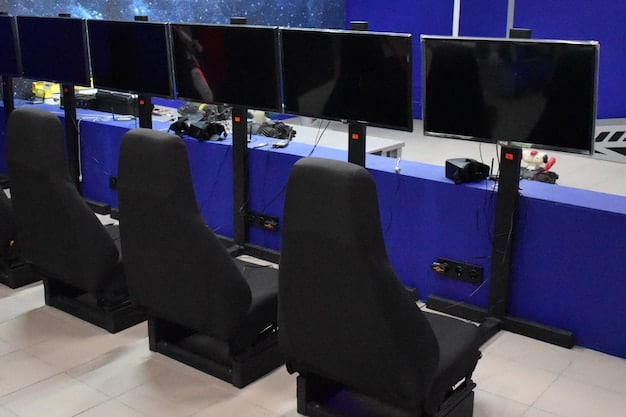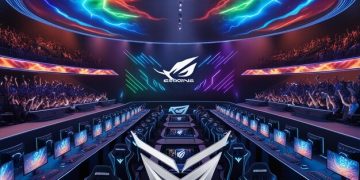New Opportunities for Amatuer Players in US Esports in 2025

The landscape of US esports tournaments in 2025 presents a dynamic array of new opportunities for amateur players, driven by technological advancements, community-based initiatives, and enhanced accessibility in competitive gaming.
As the competitive gaming scene continues its meteoric rise, a crucial question emerges for aspiring competitors: What are the New Opportunities for Amateur Players in US Esports Tournaments in 2025? This isn’t merely about dreaming of professional contracts; it’s about the tangible pathways being forged for grassroots talent, offering unprecedented access and development.
The Evolving Landscape of US Esports Tournaments
The esports ecosystem in the United States is in constant flux, characterized by rapid innovation and a growing dedication to inclusivity. Once dominated by a select few professional organizations and massive, high-stakes events, the competitive arena is now broadening its horizons. This expansion signals a significant shift, creating space for amateur players to find their footing and climb the ranks.
This evolving landscape is not just about more tournaments; it’s about a diversification of formats, prize pools, and accessibility points. Traditional competitive structures are being complemented by community-driven events, collegiate leagues, and online platforms designed specifically to nurture aspiring talent. The focus is shifting from solely discovering the next superstar to fostering a sustainable pipeline of skilled players at every level.
Grassroots Growth and Community Initiatives
A cornerstone of new amateur opportunities lies within the grassroots movement. Local area networks (LANs), community centers, and university clubs are increasingly hosting structured tournaments. These events often provide a lower barrier to entry, allowing players to gain crucial competitive experience without the immediate pressure of large professional stages.
- Increased financial backing for local organizers.
- Dedicated online platforms for community-led events.
- Mentorship programs connecting pros with amateurs.
These initiatives frequently receive support from game publishers and larger esports organizations, recognizing that a healthy amateur scene is vital for the long-term health and growth of the entire ecosystem. This symbiotic relationship ensures that more individuals have access to organized play.
Technological Advancements and Platform Accessibility
Advancements in technology play a pivotal role in democratizing access to esports. Improved streaming capabilities, robust anti-cheat systems, and user-friendly tournament platforms make it easier for organizers to host events and for players to participate from virtually anywhere. This digital infrastructure facilitates a more consistent and fair competitive environment.
The development of AI-powered analytics tools also provides amateur players with insights previously reserved for professionals. These tools can analyze gameplay, identify weaknesses, and suggest strategies, offering a personalized coaching experience that accelerates skill development. Such technological democratization is a game-changer for underexposed talent.
The synthesis of community efforts and technological progress is fundamentally reshaping the competitive landscape. It’s creating an environment where talent can be discovered and refined not just through raw skill, but through sustained engagement and continuous improvement made possible by accessible resources. This foundational shift is what makes 2025 a pivotal year for US amateur esports.
Expanded Collegiate and Scholastic Esports Programs
Collegiate and scholastic esports have rapidly emerged as one of the most significant pathways for amateur players in the US. What began as informal campus clubs has blossomed into a formalized structure, offering legitimate competitive avenues, academic support, and even scholarship opportunities. This sector is strategically positioned to nurture talent from an early age, providing a structured environment for skill development and competitive exposure.
Universities across the nation are investing heavily in esports programs, recognizing their potential to attract and retain students, foster community, and even generate revenue. This investment translates directly into better facilities, dedicated coaching staff, and organized league play, all of which benefit the amateur player looking to elevate their game beyond casual play.
Scholarship Opportunities and Academic Support
One of the most compelling aspects of collegiate esports is the increasing availability of scholarships. These scholarships can significantly offset the cost of higher education, making competitive gaming a viable career path not just for its direct monetary rewards, but for its educational benefits as well. This financial incentive encourages more students to pursue esports seriously, often alongside demanding academic pursuits.
- Tuitions waivers and grants for esports athletes.
- Academic advising and tutoring services.
- Opportunities to combine esports with related degrees (e.g., game design, sports management).
Beyond scholarships, collegiate programs often provide academic support systems. Balancing competitive gaming with a full course load can be challenging, and universities are developing resources to ensure student-athletes succeed in both arenas. This holistic approach supports the long-term well-being and development of players, preparing them for careers both inside and outside of esports.
Structured League Play and Regional Competitions
Collegiate esports leagues, such as NACE (National Association of Collegiate Esports) and Tespa (formerly an intercollegiate esports organization), provide highly structured competitive environments. These leagues organize regular season play, playoffs, and national championships, mirroring the professional leagues and giving amateur players a taste of high-stakes competition.
The establishment of regional competitions further decentralizes the esports scene, allowing for more localized rivalries and easier travel for teams. These regional events serve as crucial stepping stones, enabling teams to test their mettle before advancing to larger, national stages. This tiered system helps players adapt to increasing levels of competition incrementally.
The integration of esports into the academic fabric of US institutions provides a sustainable and credible pathway for amateur players. It bridges the gap between casual interest and professional aspiration, offering a supportive environment for skill improvement, team-building, and personal growth, all while securing an education.
The Rise of Semi-Professional and Developmental Leagues
Between the expansive amateur scene and the pinnacle of professional play, a new crucial layer is solidifying in the US esports ecosystem: semi-professional and developmental leagues. These structures are specifically designed to bridge the gap, offering amateur players a taste of professional-level competition without the full contractual obligations and intense pressure of tier-one leagues. This segment is vital for skill refinement, team cohesion, and attracting the attention of larger organizations.
Many of these leagues operate with a mix of online and offline components, providing flexibility for players still balancing school or work. They often feature smaller prize pools, but the true value lies in the exposure, structured gameplay, and the opportunity to compete against other top-tier amateur and aspiring professional talent. For players contemplating a full-time esports career, these leagues serve as invaluable testing grounds.
Pathways to Professional Organizations
A primary objective of developmental leagues is to create clear pathways to professional organizations. Many established esports teams are now actively scouting talent from these lower-tier leagues, seeking players who demonstrate not only mechanical skill but also strong teamwork, communication, and a professional attitude. Success in these leagues can directly lead to tryouts or even contracts with academy teams or main rosters in top-tier organizations.
- Direct scouting by professional teams.
- Exposure to professional-grade equipment and coaching staff.
- Networking opportunities with industry figures.
Some professional organizations are even creating their own “academy” or “cadet” teams within these developmental leagues. This allows them to nurture talent in-house, teaching them the organization’s philosophy and preparing them for future progression up the ranks. It’s a structured approach to talent identification and development.
Improved Infrastructure and Support for Players
The infrastructure supporting semi-professional leagues is continually improving. This includes dedicated league organizers, robust broadcasting capabilities, and even rudimentary player support systems. While not as comprehensive as professional organizations, these leagues aim to provide a more stable and supportive environment than ad-hoc amateur tournaments.

This includes features like: structured match schedules, dispute resolution mechanisms, official rule sets, and sometimes even basic performance analysis tools. The goal is to simulate the professional environment as closely as possible, preparing players for the rigors and expectations of competitive play at a higher level. This commitment to supporting players off the digital battlefield is as crucial as supporting them on it.
The strengthening of semi-professional and developmental leagues represents a maturation of the US esports scene. It provides a necessary interim step for amateurs with significant potential, allowing them to hone their skills and gain recognition in a competitive, yet supportive, setting before making the leap to full professional status. This tiered system is essential for sustainable talent growth.
Increased Accessibility Through Online Platforms and Tools
The digital revolution has profoundly impacted the accessibility of esports, particularly for amateur players in the US. Where once physical proximity to a dedicated venue or a high-end setup was almost a prerequisite, online platforms and innovative tools have democratized participation. This increased accessibility means that geographical location, financial constraints, or even time limitations are less of a barrier to entry into competitive play than ever before.
From custom matchmaking systems to integrated tournament platforms, the infrastructure supporting online competitive gaming has become incredibly robust. This evolution allows for a broader base of players to engage, discover their potential, and find like-minded individuals to compete with and against, without necessarily having to leave their homes.
User-Friendly Tournament Organizers and Platforms
A significant development has been the proliferation of user-friendly online tournament organizers. Platforms like Battlefy, Challengermode, and local Discord communities have simplified the process of creating, joining, and managing competitive events. These platforms often provide automated bracket generation, score reporting, and even rudimentary prize distribution, making it easy for anyone to host or participate in a tournament.
- Automated bracket and match scheduling.
- Integrated communication tools for teams and players.
- Seamless score reporting and leaderboard management.
This ease of use has empowered countless individuals and small communities to establish thriving competitive scenes for various games. It lowers the barrier for event organizers, which in turn leads to a greater number and variety of opportunities for amateur players to test their skills in structured environments.
Advanced Training Tools and Analytics
The availability of advanced training tools and analytical software, often free or at low cost, has leveled the playing field for amateurs. These tools, sometimes integrated directly into game clients or offered by third-party developers, provide deep insights into gameplay performance. Players can analyze their own replays, track key statistics, and even receive automated feedback on their decision-making and mechanics.
For example, some tools utilize AI to pinpoint common mistakes, identify optimal build paths, or suggest counter-strategies based on opponent behavior. This personalized data was once the domain of professional teams with dedicated analysts. Now, amateur players can leverage similar insights to accelerate their learning curve and identify areas for improvement more efficiently. This self-improvement potential is unprecedented.
The combination of accessible online tournament infrastructure and sophisticated training tools means that skill development is no longer primarily dependent on resources or geography. It’s increasingly about dedication and smart practice, opening up competitive opportunities to a much wider demographic of players across the US, redefining what it means to be an amateur in esports.
Niche Game Titles and Emerging Genres
While juggernauts like League of Legends, Counter-Strike, and Valorant continue to dominate the esports headlines, a significant segment of new opportunities for amateur players is emerging within niche game titles and burgeoning genres. This expansion beyond the established tier-one games provides a less crowded, often more accessible, competitive landscape where dedicated players can carve out a name for themselves and even a professional path.
These games might not boast multi-million dollar prize pools from day one, but they offer passionate communities, growing competitive structures, and a chance for players to be pioneers in an evolving esports scene. It’s an arena where expertise in a less saturated title can translate into significant competitive advantage and recognition.
Growth of Mobile Esports and Fighting Game Community (FGC)
Mobile esports has seen an explosion in popularity, particularly with titles designed for touchscreens. Games like Mobile Legends: Bang Bang, PUBG Mobile, and Call of Duty: Mobile have massive global player bases, and their competitive scenes are rapidly developing in the US. The accessibility of mobile gaming – virtually everyone has a smartphone – expands the amateur talent pool exponentially.
- Lower hardware barrier to entry compared to PC.
- Frequent community tournaments and online ladders.
- Specific skill sets adaptable from traditional esports.
Similarly, the Fighting Game Community (FGC), encompassing titles like Street Fighter, Tekken, and Guilty Gear, has always offered robust amateur opportunities. The FGC thrives on local tournaments and a strong community spirit, providing consistent competitive avenues for players of all skill levels. Its one-on-one nature often simplifies team coordination issues, making it highly attractive for individual competitive growth.
Opportunities in Indie and Developing Titles
Beyond established genres, a continuous stream of indie games and newly released titles are experimenting with competitive gameplay. While not every game will become the next major esport, some build dedicated communities and develop organic competitive scenes. For amateur players, becoming proficient in an emerging title early can offer a significant first-mover advantage if the game takes off competitively.
These opportunities often come with direct access to game developers, influencing the competitive balance and design. Players who engage early can help shape the meta and even the future of the game’s competitive circuit. It’s a chance to be part of something from the ground up, rather than trying to break into an already established and highly saturated scene.

The diversification of competitive titles caters to a broader range of skills and interests, ensuring that no amateur player who is passionate about competitive gaming feels left out. These niche and emerging scenes are vital incubators for new talent and innovative competitive formats, promising a vibrant and varied future for US amateur esports.
Financial Incentives and Sponsorships for Amateurs
While the allure of professional esports often centers on multi-million dollar contracts and global fame, the financial landscape for amateur players is also undergoing significant positive changes. The traditional model of ‘play for free, hope to get noticed’ is slowly giving way to a more structured system where even amateur participation can yield tangible financial incentives and sponsorship opportunities. This shift is crucial for motivating players and providing a sustainable pathway to professionalization.
These financial opportunities extend beyond direct prize money in tournaments. They encompass various forms of support, from equipment sponsorships to personal branding deals, all of which contribute to creating a more viable environment for aspiring esports athletes. The ecosystem recognizes that investing in the grassroots ultimately strengthens the entire competitive structure.
Growing Prize Pools for Tier 2 and Community Tournaments
The prize pools for tier 2 and even community-level tournaments are steadily increasing. This is due to a combination of factors: direct investments from game publishers, sponsorships from non-endemic brands looking to tap into the esports market, and crowdfunding initiatives from passionate communities. While these prizes may not be life-changing, they represent a significant incentive for amateur players.
- More frequent cash prizes for top performance.
- Non-cash prizes like gaming peripherals and merchandise.
- Travel and accommodation support for offline events.
For many amateurs, winning even a modest cash prize can help cover equipment costs, game purchases, or simply provide motivation to continue improving. It transforms esports from a purely recreational pursuit into one with tangible, immediate rewards, making the commitment more justifiable.
Emergence of Personal Branding and Content Creation
Beyond traditional tournament earnings, amateur players have unprecedented opportunities to leverage personal branding and content creation. Platforms like Twitch, YouTube, and TikTok allow players to stream their gameplay, create tutorial videos, or showcase their personalities. A strong following can translate into direct revenue through subscriptions, donations, and ad revenue.
Moreover, building a significant online presence makes amateur players attractive to sponsors. Brands are increasingly eager to partner with influential gamers, regardless of their professional status, to reach specific demographics. This can lead to endorsement deals, equipment sponsorships, and even paid opportunities to represent brands at events. This dual path of competitive play and content creation offers a diversified income stream.
The evolving financial landscape demonstrates a maturing ecosystem that recognizes and rewards amateur talent. By providing more consistent financial incentives and empowering players to build their personal brands, the US esports scene is creating a more sustainable and appealing environment for those aspiring to ascend the ranks from amateur to professional.
The Role of Data Analytics and Performance Coaching
Precision is becoming paramount in competitive esports, and for amateur players in the US, the increasing availability of data analytics and performance coaching is a game-changer. What was once the exclusive domain of elite professional teams with dedicated analytical staff and performance psychologists is now seeping into the amateur scene, offering unprecedented opportunities for objective self-improvement and strategic development. This systematic approach to training moves beyond raw mechanical skill, embracing the mental and analytical aspects of competitive play.
The democratization of these tools empowers players to understand their strengths and weaknesses with unparalleled clarity. It allows for a more focused and efficient training regimen, accelerating the learning curve and helping players reach their full potential more quickly. This shift enables a more scientific approach to ascending the competitive ladder.
Accessible Performance Data and Replay Analysis
Modern game clients and third-party applications provide amateur players with detailed performance data previously unavailable. This includes metrics such as kill/death ratios, damage output, objective control, vision score, and even specific micro-interactions. Players can review their gameplay with statistical breakdowns, identifying patterns and areas for improvement.
- Automated identification of common mistakes (e.g., poor positioning, missed abilities).
- Heatmaps showing movement and engagement zones.
- Comparison tools against professional player data.
Furthermore, robust replay systems allow players to re-watch their matches from various perspectives, analyzing their decision-making in real-time and even reviewing opponent strategies. This visual and statistical feedback loop is invaluable for learning from mistakes and refining tactics in a continuous cycle of improvement.
Dedicated Amateur Coaches and Mentorship Programs
The growth of the amateur scene has also led to a rise in dedicated performance coaches who specialize in working with aspiring players. These coaches, often former semi-pros or high-ranking amateurs themselves, offer individualized feedback, strategic guidance, and mental fortitude training. They bridge the gap between raw talent and competitive readiness, providing structured development plans.
In addition to paid coaching services, many community-driven mentorship programs are emerging. These programs connect experienced players with newcomers, offering advice, sharing insights, and fostering a supportive learning environment. This peer-to-peer and expert-to-novice knowledge transfer is crucial for spreading best practices and cultivating a culture of continuous improvement.
The integration of data analytics and performance coaching democratizes professional-level training methodologies, making them accessible to a broader base of amateur players. This empowers individuals to train smarter, not just harder, and provides a clear, data-driven path for aspiring competitors to refine their skills and elevate their game in the evolving US esports landscape.
| Key Opportunity | Brief Description |
|---|---|
| 🌱 Grassroots Development | Community & local tournaments growing, backed by publishers, offering entry experience. |
| 🎓 Collegiate Esports | Scholarships and structured competitive leagues providing clear pathways for students. |
| 🌐 Online Platforms | User-friendly tools & analytics democratize access to tournaments and training. |
| 📈 Niche Game Growth | Emerging titles and genres like mobile & FGC offer less saturated competitive space. |
Frequently Asked Questions About US Amateur Esports
▼
Age requirements vary significantly by tournament and game. Many collegiate leagues require participants to be enrolled students. Younger players, often under 18, may participate in scholastic leagues or community events with parental consent. Specific age limits are typically outlined in tournament rule sets.
▼
Not necessarily. While high-end gear can provide a competitive edge, many amateur tournaments and online leagues are accessible with standard gaming setups. Mobile esports, for instance, only require a compatible smartphone or tablet. Focus on consistent performance over top-tier equipment initially.
▼
Numerous online platforms like Battlefy and Challengermode list upcoming tournaments. Local gaming cafes, university esports clubs, and community Discord servers are also excellent resources for finding regional events. Social media groups dedicated to specific games often announce local competitions as well.
▼
Yes, paths are increasingly being formalized. Success in collegiate leagues, developmental leagues, and consistent high-level performance in online ladders can attract the attention of professional scouts. Many pro teams also have academy rosters that recruit promising amateur talent.
▼
Beyond raw mechanical skill, crucial attributes include strong communication, teamwork, adaptability, and resilience. The ability to learn from mistakes, maintain a positive attitude, and consistently practice are also vital for long-term improvement and success in competitive esports.
Conclusion
The landscape of US esports tournaments in 2025 truly represents a new frontier for amateur players. No longer a distant dream, a career in esports is becoming a tangible, albeit challenging, aspiration. The confluence of growing grassroots initiatives, strengthened collegiate programs, the proliferation of online platforms, expanding opportunities in diverse game titles, increased financial incentives, and accessible analytical tools has created an ecosystem ripe with potential. For any amateur player with the dedication, skill, and desire to compete, the pathways to enter, grow, and potentially ascend the ranks of competitive gaming in the United States have never been more numerous or clearly defined.





